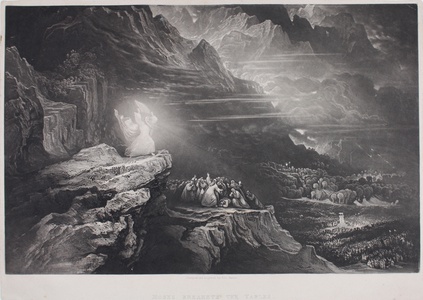| Method | Mezzotint |
| Artist | John Martin |
| Published | [London, Charles Tilt, Fleet Street. c. 1838] |
| Dimensions | Image 187 x 287 mm, Sheet 210 x 295 mm |
| Notes |
John Martin's Illustrations of the Bible was the most ambitious project of Martin's career. He set out to produce a folio of forty illustrations depicting both the Old and New Testaments. The work was first issued in 1831, in parts containing two mezzotints as well as supporting Biblical passages. After laudatory reviews for the first seven installments, parts VIII to X were published simultaneously, and somewhat paradoxically, and went almost unnoticed by critics. As a result of this, the venture was a commercial failure, and Martin sold the plates to the publisher Charles Tilt in 1838, who republished the series. Tilt's successor, David Bogue, continued selling these works until 1853. Martin's engraving illustrates part of the story of the Ten Commandments. Moses has descended from the heights of Mount Sinai carrying the tables of stone upon which God had inscribed the Ten Commandments. In the valley below him are the Israelites whom he has returned to find worshipping a golden idol of a calf. In his rage at discovering the pagan worship, Moses hurls the tables down the mountainside, breaking them to pieces. John Martin (1789-1854) was an English painter, illustrator and mezzotint engraver. He achieved huge popular acclaim with his historical landscape paintings which featured melodramatic scenes of apocalyptic events taken from the Bible and other mythological sources. Influenced by the work of J.M.W. Turner (1775-1851) as well as Theodore Gericault (1791–1824), Eugene Delacroix (1798–1863) and Paul Delaroche (1797–1856), his paintings are characterised by dramatic lighting and vast architectural settings. Most of his pictures were reproduced in the form of engravings, and book engravings, from which he derived his fortune. Despite his popularity, Martin's work was spurned by the critics, notably John Ruskin, and he was not elected to the Royal Academy. His fame declined rapidly after his death, although three of his best known works of religious art toured Britain and America in the 1870s: The Great Day of his Wrath (1853, Tate, London), The Last Judgment (1853, Tate) and The Plains of Heaven (1851-3, Tate). A great contributor to English landscape painting, Martin was a key influence on Thomas Cole (1801-48), one of the founding members of the Hudson River School. CW 104; Campbell, Visionary Printmaker, p. 141. Condition: Trimmed within plate mark, with loss of publication line. Filled small worm hole to right centre of image. |
| Framing | unmounted |
| Price | £200.00 |
| Stock ID | 46031 |

